
Deck Helmet’s Refacing System
-
Low Pressure Cleaning of entire deck except flat surfaces that are being removed
-
Re-secure your entire deck, including the rails
-
Removal of existing decking on flat surfaces and top rails
-
Install Trex or Veranda Capped Composite on flat surfaces & top rails
-
Apply Credit Card thick composite coating to Rails Post and Verticals
-
1 or 2 tone options
| Before | During | After |
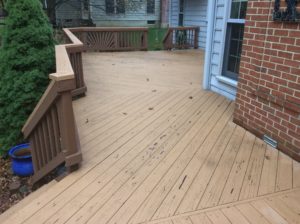 |
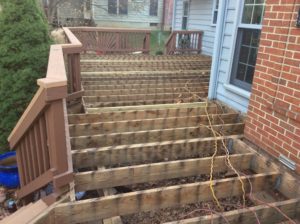 |
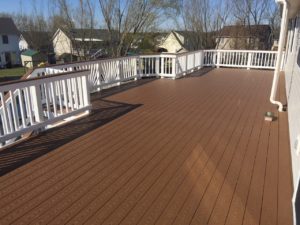 |
Deck Helmet’s Replacement System
- Removal of existing decking on flat surfaces and rails
- Install Capped Composite on flat surfaces & stairs in Trex or Composite of your choice
- Install PVC rails
- Install PVC fascia
- We have a variety of colors to choose from
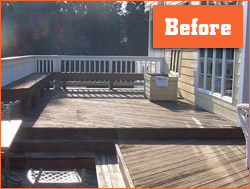 |
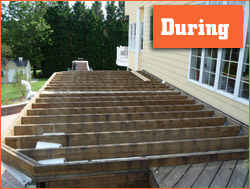 |
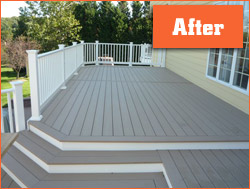 |
The Advantages of Deck Helmet

- Dramatically Reduces Maintenance Requirements.
- Eliminates Splinters & Makes Your Deck Safe Again!
- Mildew Resistant Finish.
- Prepares Your Home To Be Sold At A Premium In The Future.
- Can be installed in a fraction of the time of rebuild.
- Increases The Value Of Your Home.
Composite decking offers clear advantages over wood.
-
Composite decking requires less maintenance than wood decking.
 Composite decking is a lot like prefinished flooring. It arrives as a finished product and never needs sanding, staining, or painting — just an occasional soap and water cleaning. Wood needs to be finished after installation and then refinished every 1-2 years, meaning you’ll be spending a significant amount of time and elbow grease maintaining that deck. Explore the project photo gallery.
Composite decking is a lot like prefinished flooring. It arrives as a finished product and never needs sanding, staining, or painting — just an occasional soap and water cleaning. Wood needs to be finished after installation and then refinished every 1-2 years, meaning you’ll be spending a significant amount of time and elbow grease maintaining that deck. Explore the project photo gallery. -
Composite decking costs less over its lifetime than does wood and lasts longer, too.
 While pressure-treated lumber may cost less initially, maintenance costs are significantly higher. On average, maintaining a wood deck will cost $450-$850 per year. Composite decking? Just $5-$15 annually. What’s more, wood decks are susceptible to mold, decay and insects (not to mention Mother Nature) and have a shorter lifespan. Composites retain their good looks year after year. So that new deck look you love is the look you’ll keep.
While pressure-treated lumber may cost less initially, maintenance costs are significantly higher. On average, maintaining a wood deck will cost $450-$850 per year. Composite decking? Just $5-$15 annually. What’s more, wood decks are susceptible to mold, decay and insects (not to mention Mother Nature) and have a shorter lifespan. Composites retain their good looks year after year. So that new deck look you love is the look you’ll keep. -
Composite decking materials are eco-friendly and toxin-free.
 Composite decking is made from locally-sourced recycled plastic, lumber mill scraps and other materials. Using these materials means we prevent more than 70,000 tons of plastic and other waste from ending up in landfills or incinerators every year. Plus, our composites prevent further deforestation, do not contain the toxic chemicals often found in pressure-treated lumber, and are manufactured in a process that produces zero water waste
Composite decking is made from locally-sourced recycled plastic, lumber mill scraps and other materials. Using these materials means we prevent more than 70,000 tons of plastic and other waste from ending up in landfills or incinerators every year. Plus, our composites prevent further deforestation, do not contain the toxic chemicals often found in pressure-treated lumber, and are manufactured in a process that produces zero water waste -
Composite decking is safer.
 Wood-plastic composite decks will not splinter, split, crack, or rot, making your outdoor space safer for children, pets, and your bare feet.
Wood-plastic composite decks will not splinter, split, crack, or rot, making your outdoor space safer for children, pets, and your bare feet. -
Composite decking looks like natural wood.
 Composite decking has come a long way in the past five years. Today’s composites reflect the beauty of natural and exotic hardwoods, complete with subtle streaking and varied wood grain patterns.
Composite decking has come a long way in the past five years. Today’s composites reflect the beauty of natural and exotic hardwoods, complete with subtle streaking and varied wood grain patterns.
-
Click on the link below for the following :
Privacy Policy, Terms and Conditions,







